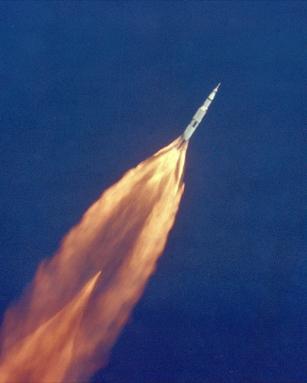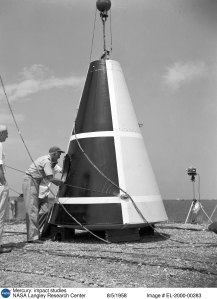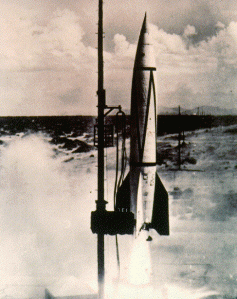 This week, Amazon.com founder and CEO Jeff Bezos announced a bold plan: to recover at least one of Apollo 11’s engines from the bottom of the Atlantic. The engines sunk to the briny deep after the Saturn V’s spent first stage jettisoned a little less than three minutes after launch on July 16, 1969. Bezos’ team of underwater experts armed with state-of-the-art sonar technology have located the engines, and he hopes to donate the recovered hardware to the Museum of Flight in Seattle. But NASA still owns the engines, and the agency gets to decide what happens to this piece of history, which may not even be form Apollo 11 at all. It’s an interesting proposal, and however Bezos’ plan for recovery unfolds, its sure to be interesting (particularly to historians). Check out my full article on Motherboard. (Left, Apollo 11 shortly after launch. The first stage’s five F-1 engines are responsible for the fiery trail the Saturn V is leaving across the sky. 1969.)
This week, Amazon.com founder and CEO Jeff Bezos announced a bold plan: to recover at least one of Apollo 11’s engines from the bottom of the Atlantic. The engines sunk to the briny deep after the Saturn V’s spent first stage jettisoned a little less than three minutes after launch on July 16, 1969. Bezos’ team of underwater experts armed with state-of-the-art sonar technology have located the engines, and he hopes to donate the recovered hardware to the Museum of Flight in Seattle. But NASA still owns the engines, and the agency gets to decide what happens to this piece of history, which may not even be form Apollo 11 at all. It’s an interesting proposal, and however Bezos’ plan for recovery unfolds, its sure to be interesting (particularly to historians). Check out my full article on Motherboard. (Left, Apollo 11 shortly after launch. The first stage’s five F-1 engines are responsible for the fiery trail the Saturn V is leaving across the sky. 1969.)
Category: Rockets
Mapping Vintage Space
 Regular readers of Vintage Space are doubtless aware that I have a tendency to link newer posts to older ones. This reflects the interrelation of all the topics I have (and will) discuss in this blog. I find this era of history to be complex (as most big historical eras are) with aspects that can be treated independently, but need to be contextualized by one another.
Regular readers of Vintage Space are doubtless aware that I have a tendency to link newer posts to older ones. This reflects the interrelation of all the topics I have (and will) discuss in this blog. I find this era of history to be complex (as most big historical eras are) with aspects that can be treated independently, but need to be contextualized by one another.
And so I thought I would begin mapping Vintage Space, building a sort of narrative roadmap that will give the more casual reader a better idea of where in the history of space and spaceflight each individual episode belongs. This is in no way a complete chronology, but rather a framework for my content. (Pictured, the sun rise above the gulf of Mexico as seen from orbit by Apollo 7. 1968.) Continue reading “Mapping Vintage Space”
The Enigmatic Vostok 1
 In previous posts, I’ve talked a little bit about how the Soviet Space Program designed its perfect cosmonaut and outlined some of the differences between Soviet and American spaceflight in the early 1960s. In both cases, Yuri Gagarin (left) has been a focal point, though I’ve never expressly treated his own mission. On April 12, 1961, Yuri Gagarin became the first man in space; his mission lasted 108 minutes and he made one orbit around the globe. Upon his return to Earth, he was lauded as a hero and the Soviet Union enjoyed its continued position as the leading power in space.
In previous posts, I’ve talked a little bit about how the Soviet Space Program designed its perfect cosmonaut and outlined some of the differences between Soviet and American spaceflight in the early 1960s. In both cases, Yuri Gagarin (left) has been a focal point, though I’ve never expressly treated his own mission. On April 12, 1961, Yuri Gagarin became the first man in space; his mission lasted 108 minutes and he made one orbit around the globe. Upon his return to Earth, he was lauded as a hero and the Soviet Union enjoyed its continued position as the leading power in space.
But in the years and decades that followed, details of the flight revealed a very different picture of this historic Soviet accomplishment. Indeed, after the fall of the Soviet Union in 1991, documentation was slowly released to reveal the secretive nature of the Soviet Space Program as a whole. In honour of the fiftieth anniversary of Gagarin’s flight, I thought I’d unravel some of the mystery. For those steeped in the history of spaceflight, these anecdotes may not be new. But for the casual reader, I hope to shed some light on the lesser-known aspects of the launch heard ‘round the world. I don’t in any way intend to denigrate the Soviet accomplishment; if anything I hope to add some depth to the stories most people find in history books surrounding Gagarin and Vostok 1. Continue reading “The Enigmatic Vostok 1”
The Lost Art of the Saturn V
 I’ve previously mentioned that once the Shuttle program ends this year, there will be no way for NASA to launch manned missions. It simply doesn’t have the necessary rockets to launch such a heavy payload into orbit, let alone a rocket capable of launching a heavy payload to another planet. A good example is the case of Mars. The Delta II hit its payload limit with the Mars Exploration Rovers Spirit and Opportunity, and that’s with each rover launched separately. The upcoming Mars Science Laboratory rover Curiosity is significantly larger and will use an Atlas family launch vehicle. For NASA’s Martian exploration plan to progress, as well as for the continuation of manned spaceflight, the organization needs a heavy lifting vehicle. (Pictured, the first Saturn V to launch: Apollo 4, 1967.)
I’ve previously mentioned that once the Shuttle program ends this year, there will be no way for NASA to launch manned missions. It simply doesn’t have the necessary rockets to launch such a heavy payload into orbit, let alone a rocket capable of launching a heavy payload to another planet. A good example is the case of Mars. The Delta II hit its payload limit with the Mars Exploration Rovers Spirit and Opportunity, and that’s with each rover launched separately. The upcoming Mars Science Laboratory rover Curiosity is significantly larger and will use an Atlas family launch vehicle. For NASA’s Martian exploration plan to progress, as well as for the continuation of manned spaceflight, the organization needs a heavy lifting vehicle. (Pictured, the first Saturn V to launch: Apollo 4, 1967.)
But NASA doesn’t necessarily need a new launch vehicle. The organization had the means to launch a manned mission to Mars in the 1960s using only technology of the day. The whole mission, however, depended on the titanic Saturn V rocket, a technology that is lost to the current generation. Continue reading “The Lost Art of the Saturn V”
Inventing Landings
 A couple of weeks ago I published a post outlining the principle reasons why splashdowns were a not an appropriate long-term method for astronauts returning to earth. Pointing to the ease of splashdowns as the primary reason behind their use throughout the space race is, however, presenting half the story. NASA began pursuing land landings in 1959, well before the Space Shuttle was on the drawing board. The original goal was to use a land landing system from the start. (Pictured is a model Mercury spacecraft undergoing impact tests at Langley Air Force Base. 1958.)
A couple of weeks ago I published a post outlining the principle reasons why splashdowns were a not an appropriate long-term method for astronauts returning to earth. Pointing to the ease of splashdowns as the primary reason behind their use throughout the space race is, however, presenting half the story. NASA began pursuing land landings in 1959, well before the Space Shuttle was on the drawing board. The original goal was to use a land landing system from the start. (Pictured is a model Mercury spacecraft undergoing impact tests at Langley Air Force Base. 1958.)
When NASA’s inaugural Mercury program was in its infancy and the base decisions about the program were being made, one of the central unknowns in spaceflight was how to bring a spacecraft back to earth. Like designing astronauts, spacecraft, as well as launch vehicles, determining how to land a spacecraft was a new problem with precious little pre-existing knowledge on which to build. Continue reading “Inventing Landings”
V-2: The Vehicle that Launched the Space Age
 Two of my previous posts tease out the main differences in the landing methods employed by both NASA and the Soviet Space Program as a means of illustrating the contrast between the two programs. What these posts don’t draw attention to is the large number of similarities between the two conflicting powers in their respective approaches to spaceflight.
Two of my previous posts tease out the main differences in the landing methods employed by both NASA and the Soviet Space Program as a means of illustrating the contrast between the two programs. What these posts don’t draw attention to is the large number of similarities between the two conflicting powers in their respective approaches to spaceflight.
In the early space age, both the US and the USSR pursued accelerated methods to get a man in space. Both achieved initial flights with capsule-style spacecrafts on top of ballistic missiles. This similar method had a common root: both countries based their launch vehicles, at least in part, on the Nazi V-2 rockets. Both had access to and exploited this technology in the wake of the Second World War. Admittedly the history of the V-2 is slightly on the fringe of the history of spaceflight proper, but a familiarity with the roots of the rocketry that launched the space age adds a dimension to the American and Soviet programs that is otherwise lost. Continue reading “V-2: The Vehicle that Launched the Space Age”
